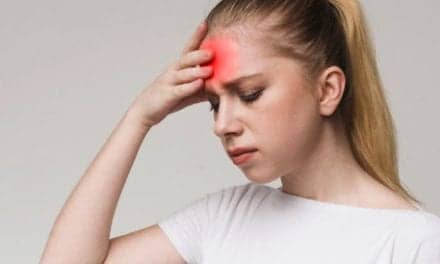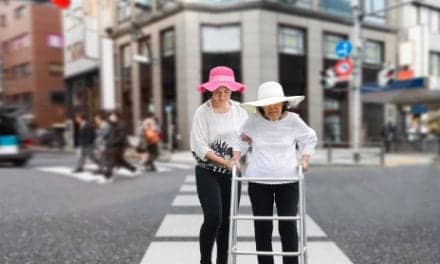
Patient suffered CVA with resultant right sided hemiparesis. Here, he dons a custom molded ankle foot orthosis and is educated about proper donning/doffing, skin care, and wearing schedule. This particular brace is used to enhance clearance of right lower extremity during ambulation as well as provide joint alignment and stability.
In the rehabilitation world, there are a number of approaches to manage the physical sequelae that occur post-stroke. One of those sequelae is foot drop, which is most common among the impairments characteristic of post-stroke patients, and experienced by an estimated 20% of all stroke survivors.1 Since foot drop affects ability to safely ambulate throughout the home and community, retraining the impaired muscles that contribute to foot drop becomes a priority. Lower-extremity bracing is one measure that can be used to manage foot drop. Correctly timing the decision to fit a patient with a brace or other orthosis has been heavily discussed in the literature, and understanding the considerations that can help pinpoint that optimum time are explored in this article.
Multidisciplinary Expertise is Essential
At the Kessler Institute for Rehabilitation, patients affected by stroke are seen for initial bracing evaluations during the inpatient and outpatient phases of recovery. They are also reassessed as needed throughout the continuum of care. For some patients, a brace or orthosis for daily use may be prescribed. In such cases, a team of rehabilitation professionals is called on to participate in the decision-making process.
The team physician leads the decision-making process and is ultimately responsible for determining which orthotic best suits the patient’s needs. The physical therapist assists with the bracing decision-making process by contributing gait analysis expertise. An orthotist designs and fabricates an ankle-foot orthosis (AFO) when prescribed, provides expertise in biomechanical gait principles, and integrates that expertise with orthotic-based materials. The patient/caregiver provides feedback for discussion among the other team members and ultimately makes the decision about bracing based on recommendations made by the team.
Other factors weighed during the decision-making process for bracing include limited insurance or financial restrictions put on custom bracing, limited access to an orthotist, and likelihood of compliance.
Timing Variables
Making the decision about the optimal point in time to fit a patient with an orthosis is multifactorial. This decision can be dependent on discharge disposition with particular regard to whether the patient is discharging to home, and if safety is a primary concern secondary to a lack of ankle control. The level of impairment as well as weakness and instability should be taken into consideration, coupled with any prognostic indicators for a positive return in muscle control.
Many variables can account for how an AFO can improve walking endurance and functional ambulation long-term among patients affected by chronic stroke. For example, the AFO will create ankle joint stability and enhance foot clearance through swing phase of gait. This will alter gait mechanics and ultimately help to enhance the patient’s confidence in their own gait ability. An AFO preserves first ankle rocker with hemiplegic patients and provides a more efficient weight acceptance at initial contact to allow for enhanced double limb support and, thus, increased gait speed.2 Gait efficiency is also an important factor to consider when discussing energy expenditure and a patient’s ability to perform functional ambulation. Dynamic AFOs were shown to decrease energy cost of walking, as demonstrated from the Physiological Cost Index when compared to shoes only with chronic stroke patients.3
Comparing Braces and Orthoses
There are important pros and cons for each type of orthosis, with cost and weight the two most common factors. Also, there are drawbacks generally associated with the use of an orthosis that include compliance secondary to comfort, limited ankle motion, and a relatively fixed position (unless an articulating AFO is prescribed).
Part of the decision about bracing may come down to trade-offs between a customized AFO and an “off the shelf,” prefabricated brace. The advantages each confers are distinct. For example, a custom molded AFO offers the ability to create an optimal fit and provides maximum control of the limb. In contrast, while mass-produced prefabricated orthoses may sacrifice quality of fit and limb control, they can be used as an evaluative tool or a short-term fix during the rehabilitation process.
The conventional double upright AFO is another common bracing solution that may require review by the multidisciplinary team. This design is used when there is significant or fluctuating edema that may constrict the limb and present pressure-related issues with the fit of an AFO. An articulating (hinge) AFO is used to assist with continued dorsiflexion and allow for great ankle ROM. It is not appropriate if spasticity is present, and can be challenging for shoe wear because width is typically wider to accommodate joint of brace.
Carbon composite AFOs are a dynamic bracing option that allow for push-off during third (forefoot) ankle rocker of gait. These AFOs are made to keep the foot up during swing phase, and provide a soft heel strike and stability in stance. This type of brace is contraindicated for patients affected by significant edema, ulcers, and spasticity. Several types of carbon composite AFOs are offered by Allard USA, Rockaway, NJ, including the ToeOFF, ToeOFF Short, BlueROCKER, KiddieROCKER, KiddieGAIT, and Ypsilon. Each brace in this carbon fiber AFO product line is designed to offer specific benefits such as increased rigid orthotic control, size optimized to wearer’s stature, and to accommodate varying levels of spasticity.
Posterior Leaf Spring (PLS) is another common bracing option usually offered as a prefabricated product. The Superior C-90 from AliMed, Dedham, Mass, is an example of this type of brace, and built to provide a full range of plantar and dorsiflexion. The Superior C-90 also provides a thin trim line and allows for eccentric lowering of foot and dorsiflexion for tibial advancement over foot through mid-stance. One drawback to this design, however, is the lack of medial/lateral stability of ankle and poor knee control. It is also contraindicated for patients with spasticity and genu recurvatum or extensor thrust.
Functional Electrical Stimulation is an Option
Orthoses engineered to provide functional electrical stimulation (FES) to the wearer during use can be an alternative to traditional AFOs. The use of FES, particularly for lower extremity bracing, has been associated with increased gait velocity, decreased energy expenditure with gait, and improved gait symmetry. Two manufacturers that provide these devices include Reno, Nevada-based Innovative Neurotronics, which manufactures the WalkAide, and Valencia, Calif-headquartered Bioness, which manufactures the Bioness L300. Among the two products’ distinguishing structural characteristics, the WalkAide has a built-in tilt sensor while the L300 is designed with a heel switch sensor. Both products are considered FES devices, yet the mechanism of action used by each differs slightly.
At Kessler, the Bioness L300 is available for patients to trial. In my experience, and one of the advantages of using the L300, is the result in physiological changes such as increased muscle strength, improved volitional control, and increased joint range of motion. These changes indicate an increased therapeutic effect not associated with the use of traditional AFOs. Another advantage is highlighted in a study by Everaert et al that examined patient preferences for devices and revealed a statistical difference between patients who preferred to use the WalkAide versus an AFO.4 An additional benefit of using FES devices is a purported decrease in spasticity, which further improves the therapeutic effect.
There are some drawbacks associated with the use of an FES device, however, and the most common is cost. Third-party payors often decline coverage for FES devices, so the cost typically falls to the patient. The patient must also tolerate the stimulation so the motor nerve can be activated. Skin irritation is an undesirable side effect, and the wearer’s tolerance must be carefully monitored. Contraindications for these devices include demand-type pacemakers, any cancerous lesion, fractures, or dislocation. Cognitive impairment that could affect ability to use the device is another important consideration. Ultimately, the decision to use a brace as therapeutic treatment for foot drop is a collaboration with one goal: to improve a patient’s ability to safely ambulate and maximize functional independence. PTP
Farris Fakhoury, PT, DPT, has been a physical therapist in the Outpatient Neurologic Gym at Kessler Institute for Rehabilitation for 4 years, and is also the physical therapy lead for the facility’s amputee program. Fakhoury is the physical therapy lead for Kessler’s Amputees Coming Together (ACT) support group as well as for the Bioness program for outpatient services. He earned a bachelor of arts in psychology from Villanova University and a doctor of physical therapy from the joint program of Rutgers University/University of Medicine and Dentistry of New Jersey PT Program in Stratford, NJ. For more information, contact [email protected].
Rich Klager, PT, DPT, NCS, has been a physical therapist at the Kessler Institute for Rehabilitation in West Orange, NJ, for more than 8 years. His clinical practice experience expands over the Inpatient and Outpatient facilities in the neurologic population. He currently assists with the Outpatient orthotic clinic decision-making process with the Team Physician and Orthotist for patient bracing needs.
References
1. Bethoux F, Rogers HL, Nolan K, et al. Long term follow-up to a randomized controlled trial comparing peroneal nerve functional electrical stimulation to an ankle foot orthosis for patients with chronic stroke. Neurorehabil Neural Repair. 2015;29(10):911-922.
2. Nolan KJ, Yarossi M. Preservation of the first rocker is related to increases in gait speed in individuals with hemiplegia and AFO. Clin Biomech (Bristol, Avon). 2011;26(6):655-660.
3. Erel S, Uygur F, Engin Simsek I, Yakut Y. The effects of dynamic ankle-foot orthoses in chronic stroke patients at three-month follow-up: a randomized controlled trial. Clin Rehabil. 2011;25(6):515-523.
4. Everaert DG, Stein RB, Abrams GM, et al. Effect of foot-drop stimulator and ankle-foot orthosis on walking performance after stroke: A multicenter randomized controlled trial. Neurorehabil Neural Repair. 2013;27(7):579-591.
Additional reference:
Lusardi MM, Jorge M, Nielsen CC. Orthotics and Prosthetics in Rehabilitation. St Louis: Saunders Elsevier, 2007.





